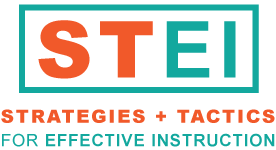Keeping track of the effects of instruction is an important part of teaching. It is the process by which teachers decide whether the approach they are using is effective with their students. Teachers also use evaluation to decide whether the methods and materials they are using are effective. And, evaluation data are used to make important decisions like whether to refer· students to specialists, whether to change interventions, and whether (or when) to exit students from programs. Evaluation activities provide a necessary and valuable loop in any effective instructional process. This is why evaluating is a key component of instruction.
Effective instruction requires evaluating. Some evaluation activities occur during the process of instruction (i.e., when teachers collect data during instruction and use those data to make instructional decisions). Other evaluation activities occur at the end of instruction (e.g., when the teacher administers a test to determine whether a pupil has met instructional objectives). There are four principles of effective evaluating:
- Monitor student understanding.
- Monitor engaged time.
- Keep records of student progress.
- Use data to make decisions.
Each of these principles implies a set of strategies that teachers use when evaluating (see Figure 42).
Monitor student understanding involves checking students to determine if they have understood a classroom instruction presentation and keeping track of their progress as a result of that instruction. The goal is to determine the extent to which students have profited from what has been taught.
Monitor engaged time involves keeping track of student participation rates or having students monitor their own behavior. The goal of monitoring engaged time is to determine the extent to which students are actively engaged in relevant, productive instructional activities rather than irrelevant, unproductive ones.
Keep records of student progress involves keeping track of student performances using a variety of procedures and sharing the results with students regularly. The goal of maintaining records of students’ progress is staying informed about performance and sharing that knowledge with students.
Use data to make decisions involves deciding when additional assistance is needed or no longer needed to meet the needs of individual students. The goal of using data to make decisions is identifying the appropriate form of assistance needed to ensure that benefits of instruction are experienced by all students.
These four evaluating principles are addressed in this section, along with a set of specific strategies that effective teachers use when focusing on each one. The main content of the unit is a set of tactics that illustrate specific ways to actively address each principle and strategy when providing effective instruction.
| Component | Principle | Strategy |
|---|---|---|
| Evaluating | 1. Monitor Student Understanding |
|
| 2. Monitor Engaged Time |
|
|
| 3. Keep Records of Student Progress |
|
|
| 4. Use Data to Make Decisions |
|
Monitor Student Understanding
Effective teachers check for procedural understanding to ensure that students know the strategy needed to actively engage in task behavior. They do so by asking students to show them or tell them the process or steps they will use to complete a task.
Rate of correct work completion is evidence that students understand the goals of instruction as well as the process to use. Incorrect or uncompleted work may be evidence of a lack of student understanding. Effective teachers keep track and monitor student success rates.
Monitor Engaged Time
Performances improve when teachers monitor their engaged learning and redirect non-engaged students, but monitoring can be a time consuming task. Students can be taught to monitor their own engaged learning time and class participation.
Keep Records of Student Progress
Regular and frequent feedback is one way to keep students informed about their progress. It helps students know what is expected of them and to what extent they are meeting expectations.
To know the extent to which students are profiting from instruction, effective teachers must keep records of their progress. Recordkeeping can be formal or in formal.
Use Data to Make Decisions
Effective instruction is about planning, managing, and delivering content to students on a daily basis. Effective teachers also evaluate whether students are learning.
A driving force behind effective instruction is the degree to which students are benefiting from instruction. Teachers and teams of specialists assess and collect information to decide whether students are making progress and/or in need of additional services.
